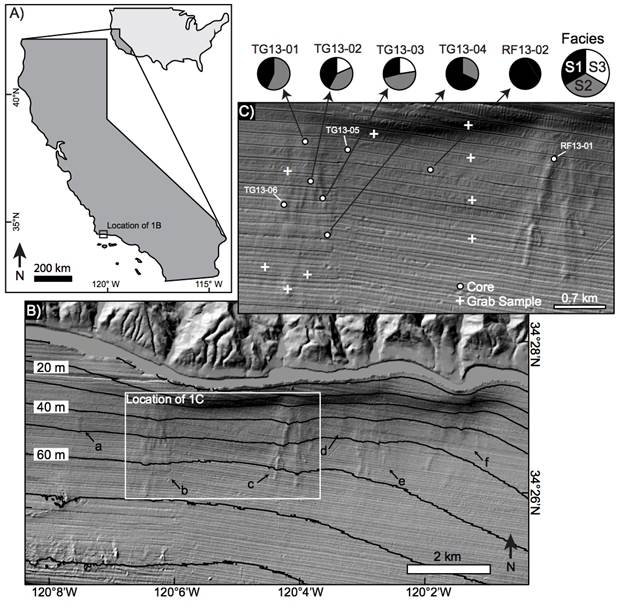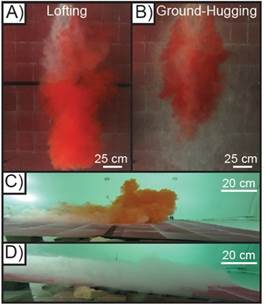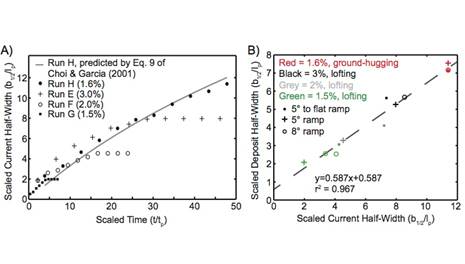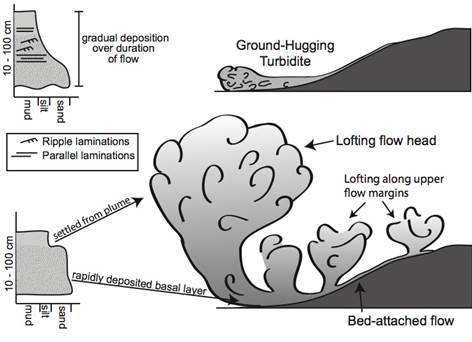Reports: ND852790-ND8: Hyperpycnal Subaqueous Fans of the Northern Santa Barbara Channel, Central California
Alexander R. Simms, PhD, University of California, Santa Barabara
Summary
The purpose of this grant was to sample and describe the enigmatic fans of the northern Santa Barbara Channel shelf. The fans were hypothesized to represent the first preserved Quaternary examples of hyperpycnal flow deposits and thus represent an important analogue for similar deposits in the rock record, which may serve as hydrocarbon reservoirs. The fans were cored and imaged using high-resolution seismic profiling. In addition, we conducted a series of experiments to replicate the features in the lab. From this work, we found that the fans were sourced from nearby creeks, likely as hyperpycnal flows, but underwent buoyancy reversal upon entering the ocean. The process of buoyancy reversal resulted in the modification of the sedimentary character and morphology of the deposits. The deposits suggest 1.) that contrary to most sequence stratigraphic models, shelves are not solely the location of bypass during highstand times, 2.) that deposits from flows undergoing buoyancy-reversal are narrower and better sorted than deposits from normal “ground-hugging” flows, and 3.) deposits whose flows experienced buoyancy-reversal may provide a possible explanation for enigmatic turbidite-like deposits in the rock record. Their characteristics also suggest that deposits from similar systems may contain excellent reservoir properties.
Activities
During the course of the grant, we collected 8 hammer cores and 8 grab samples in water depths between 20 and 70 m (Fig. 1) and approximately 30 km of high-resolution seismic data over the fans. We also collected sediment samples from the estuaries and creeks at the head of the fans to characterize the sources of sediment for the fans and conducted 3-dimensional flume experiments at the University of Texas at Austin to replicate these features in the lab. The cores were cut, photographed, and described. In addition, the cores provided the materials for 14 radiocarbon dates used to confirm their origin and 185 grain-size measurements to differentiate the flow deposits from background shelf deposition. We used a recently published statistical technique to use the grain-size data to differentiate beds within the fan deposits.
Figure 1. Location of study area, cores, and grab samples taken for this project (Steel et al., in press).
Findings
We found that the sediments from the fans contained well-sorted clean structureless sands with both terrestrially-derived plant material and shells from a range of water depths (Fig. 2). The plant material confirms the fluvial origin to the flows and that the flows traveled across and eroded into the seafloor. Both observations support their hyperpycnal origin. However, their characteristics do not agree with former models of hyperpycnal flows (e.g. no grading) but are similar to characteristics thought to be generated by flows undergoing buoyancy reversal. Buoyancy reversal is the processes by which flows with lighter interstitial fluids than the ambient waters reach a point of equivalent buoyancy and the flow separates into two parts. The fine-grained suspended load lifts of the bed to become a buoyant plume and the bedload transitions into a debris-flow like deposit. Thus these fans provide the first field example of this process with the flows representing the bedload deposition following liftoff of the plume (thus explaining the clean, well-sorted nature of the deposits; Fig. 2). In addition, the ages from the flows general fall between 500 and 8000 cal years BP (Fig. 2) and the flows themselves all lie above a transgressive ravinement surface placing them within the highstand systems tract.
Figure 2. Core description, grain-size, and radiocarbon ages from cores taken on the subaqueous fans of the Santa Barbara Channel (Steel et al., in press). See Figure 1 for core locations.
Flume experiments conducted to replicate buoyancy reversal confirm the field observations and add new insights into their characteristics. First, deposits from flows undergoing buoyancy reversal are narrower than normal ground-hugging flows (Fig. 3). The suspended sediment concentration and geometry of the seafloor control the point of “liftoff”, which then governs the morphology of the deposit. Generally buoyancy reversal occurs more seaward with higher slopes and more concentrated flows (Fig. 4). Thus these deposits are generally wider as they have more time to broaden before “liftoff” occurs.
Figure 3. Photographs of lofting (A) and ground-hugging (B) flows as seen from above in the flume at the University of Texas. Profile views of the same lofting (C) and ground-hugging (D) flows. (Steel et al., in review).
Figure 4. A.) Graphs illustrating the changes in width versus run time of the ground-hugging (Run H) and lofting (Runs E, F, and G) experimental flows. Numbers in parenthesis denote suspended sediment concentrations of the flows. B. Relationship between deposit and flow widths (Steel et al., in review).
Implications
We have provided the first field example of the deposits created by flows undergoing buoyancy reversal. These deposits are distinct from normal turbidites (Fig. 5) but contain high-quality reservoir sands. They may also provide an analogue for many enigmatic beds found in association with turbidites but lacking the typical diagnostic features of turbidites (e.g. grading).
The building of the fans during the highstand systems tract suggests that shelves are not always marked by sediment starvation during highstand times. In high mountainous margins such as those prevalent along many active plate boundaries, sediments delivered to high-gradient shelves may become hyperpycnal and escape the “littoral fence” on to the shelf and be preserved as shelfal fans. Thus highstand systems tracts may hold potential reservoir-quality sands.
The geometry of submarine fans is heavily influenced by the nature of the flows feeding the fans. Generally, fans fed by lofting turbidites are narrower than those from normal ground-hugging flows. In addition, the sediment concentration and seafloor gradients also play a role in determining the morphology of submarine fans. Generally steeper seafloor gradients and higher concentrated flows result in wider fans.
Figure 5. Cartoon illustrating the differences between deposits from ground-hugging (top) and lofting (bottom) flows (Steel et al., in press).
















